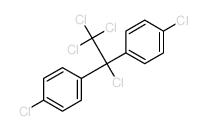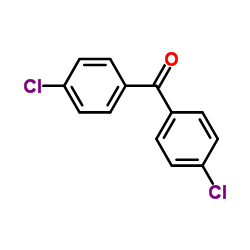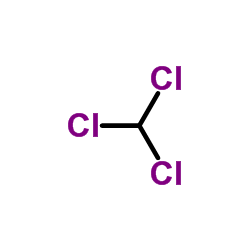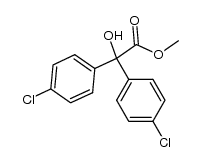Dicofol

Dicofol structure
|
Common Name | Dicofol | ||
|---|---|---|---|---|
| CAS Number | 115-32-2 | Molecular Weight | 370.486 | |
| Density | 1.5±0.1 g/cm3 | Boiling Point | 454.7±40.0 °C at 760 mmHg | |
| Molecular Formula | C14H9Cl5O | Melting Point | 78.5°C | |
| MSDS | Chinese USA | Flash Point | 228.8±27.3 °C | |
| Symbol |


GHS07, GHS09 |
Signal Word | Warning | |
| Name | dicofol |
|---|---|
| Synonym | More Synonyms |
| Density | 1.5±0.1 g/cm3 |
|---|---|
| Boiling Point | 454.7±40.0 °C at 760 mmHg |
| Melting Point | 78.5°C |
| Molecular Formula | C14H9Cl5O |
| Molecular Weight | 370.486 |
| Flash Point | 228.8±27.3 °C |
| Exact Mass | 367.909607 |
| PSA | 20.23000 |
| LogP | 5.74 |
| Vapour Pressure | 0.0±1.2 mmHg at 25°C |
| Index of Refraction | 1.626 |
| Stability | Stable. Combustible. Incompatible with strong oxidizing agents. Hydrolyzes in basic solution. Corrodes some metals. |
| Water Solubility | Slightly soluble. |
CHEMICAL IDENTIFICATION
HEALTH HAZARD DATAACUTE TOXICITY DATA
MUTATION DATA
|
| Symbol |


GHS07, GHS09 |
|---|---|
| Signal Word | Warning |
| Hazard Statements | H302-H312-H315-H317-H410 |
| Precautionary Statements | P273-P280-P501 |
| Personal Protective Equipment | dust mask type N95 (US);Eyeshields;Faceshields;Gloves |
| Hazard Codes | Xn:Harmful;N:Dangerousfortheenvironment; |
| Risk Phrases | R21/22;R38;R43;R50/53 |
| Safety Phrases | S36/37-S60-S61-S45-S16-S7 |
| RIDADR | UN 2761/3077 |
| RTECS | DC8400000 |
| HS Code | 2906299010 |
|
~% 
Dicofol CAS#:115-32-2 |
| Literature: US2812280 , ; |
|
~% 
Dicofol CAS#:115-32-2 |
| Literature: Journal of Organic Chemistry, , vol. 23, p. 1306 |
| HS Code | 2906299090 |
|---|---|
| Summary | 2906299090 other aromatic alcohols。Supervision conditions:None。VAT:17.0%。Tax rebate rate:9.0%。MFN tariff:5.5%。General tariff:30.0% |
|
Ionic liquid-mediated molecularly imprinted solid-phase extraction coupled with gas chromatography-electron capture detector for rapid screening of dicofol in vegetables.
J. Chromatogr. A. 1307 , 21-6, (2013) New ionic liquid-mediated molecularly imprinted polymers (IL-MIPs) were prepared by precipitation polymerization using 1-butyl-3-methylimidazolium hexafluorophosphate (BMIM(+)PF6(-)) as the auxiliary ... |
|
|
Food web-specific biomagnification of persistent organic pollutants.
Science 317 , 236-9, (2007) Substances that accumulate to hazardous levels in living organisms pose environmental and human-health risks, which governments seek to reduce or eliminate. Regulatory authorities identify bioaccumula... |
|
|
Pesticide residues in tomatoes from greenhouses in Souss Massa Valley, Morocco.
Bull. Environ. Contam. Toxicol. 88(3) , 358-61, (2012) Eight pesticide residues in tomato samples collected in the area of Souss Massa Valley (Southern Morocco) were analyzed. The detected residue levels ranged from 0.001 to 0.400 mg kg(-1) for dicofol, f... |
| p,p'-Kelthane |
| 4,4'-Dichloro-a-(trichloromethyl)benzhydrol |
| Benzenemethanol, 4-chloro-α-(4-chlorophenyl)-α-(trichloromethyl)- |
| Di(p-chlorophenyl)trichloromethylcarbinol |
| 4-chloro-α-(4-chlorophenyl)-α-(trichloromethyl)benzenemethanol |
| 4-Chloro-a-(4-chlorophenyl)-a-(trichloromethyl)benzenemethanol |
| Dicofol |
| 2,2,2-Trichloro-1,1-bis(4-chlorophenyl)ethanol |
| α,α,α,4,4’-pentachloro-α-methylbenzhydryl alcohol |
| p,p'-dicofol |
| 2,2,2-trichloro-1,1-bis(4-chlorophenyl)ethan-1-ol |
| 4,4'-Dichloro-α-(trichloromethyl)benzhydrol |
| EINECS 204-082-0 |
| Dicofol standard solution |
| MFCD00055271 |

![[2,2,2-trichloro-1,1-bis(4-chlorophenyl)ethyl] acetate structure](https://image.chemsrc.com/caspic/216/3567-16-6.png)
 CAS#:90-98-2
CAS#:90-98-2 CAS#:67-66-3
CAS#:67-66-3 CAS#:3567-18-8
CAS#:3567-18-8 CAS#:39144-63-3
CAS#:39144-63-3![1-chloro-4-[1-(4-chlorophenyl)ethyl]benzene structure](https://image.chemsrc.com/caspic/435/3547-04-4.png) CAS#:3547-04-4
CAS#:3547-04-4![Acetamide,N-[2,2,2-trichloro-1,1-bis(4-chlorophenyl)ethyl]- structure](https://image.chemsrc.com/caspic/373/81012-95-5.png) CAS#:81012-95-5
CAS#:81012-95-5
